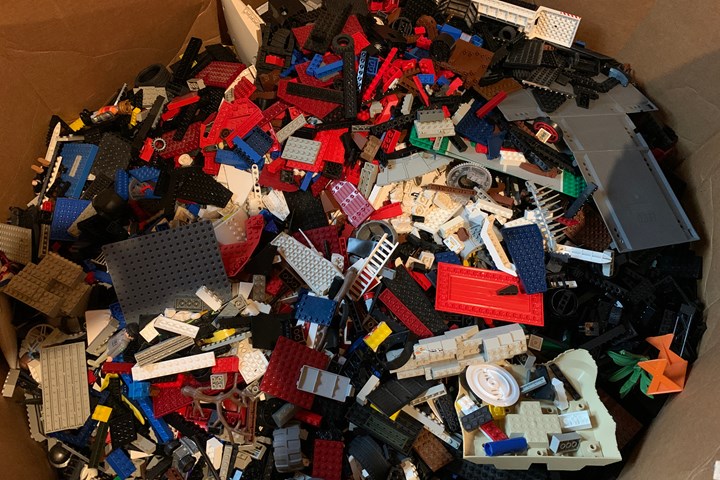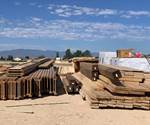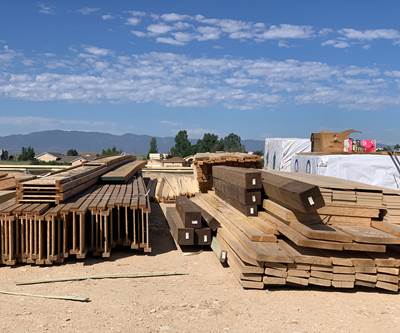
The Sloan family LEGO collection, which weighs about 100 pounds. Photo Credit: CW
When I was a kid, my parents invested heavily in LEGOs for me. Every birthday and Christmas from age six to about 13 brought me one new set or another, including a Lear Jet, a helicopter, a fire station, a police station and, when the first Star Wars came out in 1977, an X-Wing fighter. And like most kids, I dutifully followed the directions to build these sets, but eventually disassembled them and made my own creations.
As I entered high school, my interests took me in other directions, but I did manage to hold on to my LEGO collection. Keeping my LEGOs beyond their use to me was very likely motivated by nostalgia for the hours I spent on my bedroom floor, surrounded by thousands of small plastic pieces, trying to make the design in my head come to life in the structure in front of me.
When I was a kid, however, I don’t recall ever thinking that my LEGOs would have a shelf life or relevance sufficient to make them of interest to my own kids. (This might be because when I was a kid, it was nearly impossible to imagine that I would have my own kids one day.)
Anyhow, I held on to that original collection of LEGOs — probably 4,000 pieces in total — and sure enough, by the time the mid-1990s rolled around, my wife and I were on our way toward having three boys. And, of course, the nearly universal appeal of LEGOs that attracted me also attracted our boys. We started them with my now-humble collection, and then, over the years, at every birthday and Christmas, a new set was given to one or more of the kids. This was in the heyday of Harry Potter, the full Star Wars saga and superheroes — all of which were fodder for LEGOs sets. Like I did, our kids were diligent builders of each set, but proved just as willing to disassemble them to develop new creations, which were played with and displayed and then remade into something else.
I was always struck, as I built new creations, by the additive nature of LEGOs. That is, each discrete LEGO piece is, by itself, interesting but often not remarkable. It tends to be block-like or flat, clear or colored, with fixed attachment points that give it limited utility — it can only fit with certain pieces in certain places. However, as you combine one piece with another, that utility expands as your creation expands, and pieces work together to create a structure that is, it seems, greater than the sum of its parts.
Now, I did not actually have these insights as a kid — they (obviously) came much later. My revelation at the time was that it was “cool” when all these pieces scattered on the floor came together in a creation I built myself. And I was immensely proud of that creation. And I saw that same pride in my own kids with their LEGO creations.
I was reminded of all of this recently when I tried to explain to someone what I do for a living. This is not always easy to do as my explanation often gets bogged down in trying to summarize, succinctly, what composites are. This person, however, showed unusual interest and seemed to be tracking along fairly well. And then I made a mistake. I said, “Composites are the only manufacturing material that are made when the part is made.”
It’s not that I misspoke. What I said is true. Unlike steel, aluminum or any other metal, the constituents of a composite part are not united until the part itself is manufactured. If you throw in the fact that mechanical properties of a composite are anisotropic, you then have a material and process combination that is unmatched in complexity. To my listener, all of this was a bridge too far.
And then I remembered LEGOs. “Did you ever play with LEGOs?” I asked. My listener did. “If you recall, you always started with all of these small pieces, different colors, shapes, sizes, functionalities. They were unremarkable by themselves, but as you assembled them, they become part of a larger whole, which was remarkable.” This seemed to make sense to my listener, who was nodding vigorously. “Composites are kind of like that,” I said.
Well, not exactly like that, but it’s close enough. The lesson? Keep your LEGOs. You never know where they will lead you.
Related Content
Revisiting the OceanGate Titan disaster
A year has passed since the tragic loss of the Titan submersible that claimed the lives of five people. What lessons have been learned from the disaster?
Read MoreHow has CW changed in the last year?
Upon his one-year anniversary as editor-in-chief of CW, Scott Francis looks back at some of the brand’s changes and hints at where it might be heading next.
Read MoreThere's a lot up in the air
Trade tensions and supply chain shifts — what the U.S.-China dispute means for aerospace and composites suppliers.
Read MoreComposites trends of 2024: Innovating for a sustainable, high-rate future
CW's annual look back over the last year reviews the technologies, processes and sustainability initiatives still shaping the composites industry.
Read MoreRead Next
Home building with composites
There’s a house being built next door. It could be using more composites.
Read MoreCeramic matrix composites: Faster, cheaper, higher temperature
New players proliferate, increasing CMC materials and manufacturing capacity, novel processes and automation to meet demand for higher part volumes and performance.
Read MoreScaling up, optimizing the flax fiber composite camper
Greenlander’s Sherpa RV cab, which is largely constructed from flax fiber/bio-epoxy sandwich panels, nears commercial production readiness and next-generation scale-up.
Read More













